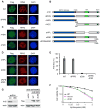The HARP-like domain-containing protein AH2/ZRANB3 binds to PCNA and participates in cellular response to replication stress
- PMID: 22705370
- PMCID: PMC3601832
- DOI: 10.1016/j.molcel.2012.05.025
The HARP-like domain-containing protein AH2/ZRANB3 binds to PCNA and participates in cellular response to replication stress
Abstract
Proteins with annealing activity are newly identified ATP-dependent motors that can rewind RPA-coated complementary single-stranded DNA bubbles. AH2 (annealing helicase 2, also named as ZRANB3) is the second protein with annealing activity, the function of which is still unknown. Here, we report that AH2 is recruited to stalled replication forks and that cells depleted of AH2 are hypersensitive to replication stresses. Furthermore, AH2 binds to PCNA, which is crucial for its function at stalled replication forks. Interestingly, we identified a HARP-like (HPL) domain in AH2 that is indispensible for its annealing activity in vitro and its function in vivo. Moreover, searching of HPL domain in SNF2 family of proteins led to the identification of SMARCA1 and RAD54L, both of which possess annealing activity. Thus, this study not only demonstrates the in vivo functions of AH2, but also reveals a common feature of this new subfamily of proteins with annealing activity.
Copyright © 2012 Elsevier Inc. All rights reserved.
Figures







Comment in
-
Finally, polyubiquitinated PCNA gets recognized.Mol Cell. 2012 Aug 10;47(3):333-4. doi: 10.1016/j.molcel.2012.07.024. Mol Cell. 2012. PMID: 22883622
Similar articles
-
Polyubiquitinated PCNA recruits the ZRANB3 translocase to maintain genomic integrity after replication stress.Mol Cell. 2012 Aug 10;47(3):396-409. doi: 10.1016/j.molcel.2012.05.024. Epub 2012 Jun 14. Mol Cell. 2012. PMID: 22704558 Free PMC article.
-
Annealing helicase 2 (AH2), a DNA-rewinding motor with an HNH motif.Proc Natl Acad Sci U S A. 2010 Dec 7;107(49):20970-3. doi: 10.1073/pnas.1011196107. Epub 2010 Nov 15. Proc Natl Acad Sci U S A. 2010. PMID: 21078962 Free PMC article.
-
The annealing helicase HARP protects stalled replication forks.Genes Dev. 2009 Oct 15;23(20):2394-9. doi: 10.1101/gad.1836409. Epub 2009 Sep 30. Genes Dev. 2009. PMID: 19793864 Free PMC article.
-
Stalled replication forks: making ends meet for recognition and stabilization.Bioessays. 2010 Aug;32(8):687-97. doi: 10.1002/bies.200900196. Bioessays. 2010. PMID: 20658707 Review.
-
Prevention of unwanted recombination at damaged replication forks.Curr Genet. 2020 Dec;66(6):1045-1051. doi: 10.1007/s00294-020-01095-7. Epub 2020 Jul 15. Curr Genet. 2020. PMID: 32671464 Free PMC article. Review.
Cited by
-
The Regulation of DNA Damage Tolerance by Ubiquitin and Ubiquitin-Like Modifiers.Front Genet. 2016 Jun 13;7:105. doi: 10.3389/fgene.2016.00105. eCollection 2016. Front Genet. 2016. PMID: 27379156 Free PMC article. Review.
-
TRIM28 functions as the SUMO E3 ligase for PCNA in prevention of transcription induced DNA breaks.Proc Natl Acad Sci U S A. 2020 Sep 22;117(38):23588-23596. doi: 10.1073/pnas.2004122117. Epub 2020 Sep 8. Proc Natl Acad Sci U S A. 2020. PMID: 32900933 Free PMC article.
-
SMARCAL1 is a dual regulator of innate immune signaling and PD-L1 expression that promotes tumor immune evasion.Cell. 2024 Feb 15;187(4):861-881.e32. doi: 10.1016/j.cell.2024.01.008. Epub 2024 Jan 31. Cell. 2024. PMID: 38301646 Free PMC article.
-
A fork in the road: Where homologous recombination and stalled replication fork protection part ways.Semin Cell Dev Biol. 2021 May;113:14-26. doi: 10.1016/j.semcdb.2020.07.004. Epub 2020 Jul 9. Semin Cell Dev Biol. 2021. PMID: 32653304 Free PMC article. Review.
-
Readers of PCNA modifications.Chromosoma. 2013 Aug;122(4):259-74. doi: 10.1007/s00412-013-0410-4. Epub 2013 Apr 12. Chromosoma. 2013. PMID: 23580141 Free PMC article. Review.
References
-
- Boerkoel CF, O’Neill S, Andre JL, Benke PJ, Bogdanovic R, Bulla M, Burguet A, Cockfield S, Cordeiro I, Ehrich JH, et al. Manifestations and treatment of Schimke immuno-osseous dysplasia: 14 new cases and a review of the literature. Eur J Pediatr. 2000;159:1–7. - PubMed
-
- Branzei D, Foiani M. The checkpoint response to replication stress. DNA Repair (Amst) 2009;8:1038–1046. - PubMed
-
- Bugreev DV, Mazina OM, Mazin AV. Rad54 protein promotes branch migration of Holliday junctions. Nature. 2006;442:590–593. - PubMed
Publication types
MeSH terms
Substances
Grants and funding
LinkOut - more resources
Full Text Sources
Other Literature Sources
Molecular Biology Databases
Research Materials
Miscellaneous

